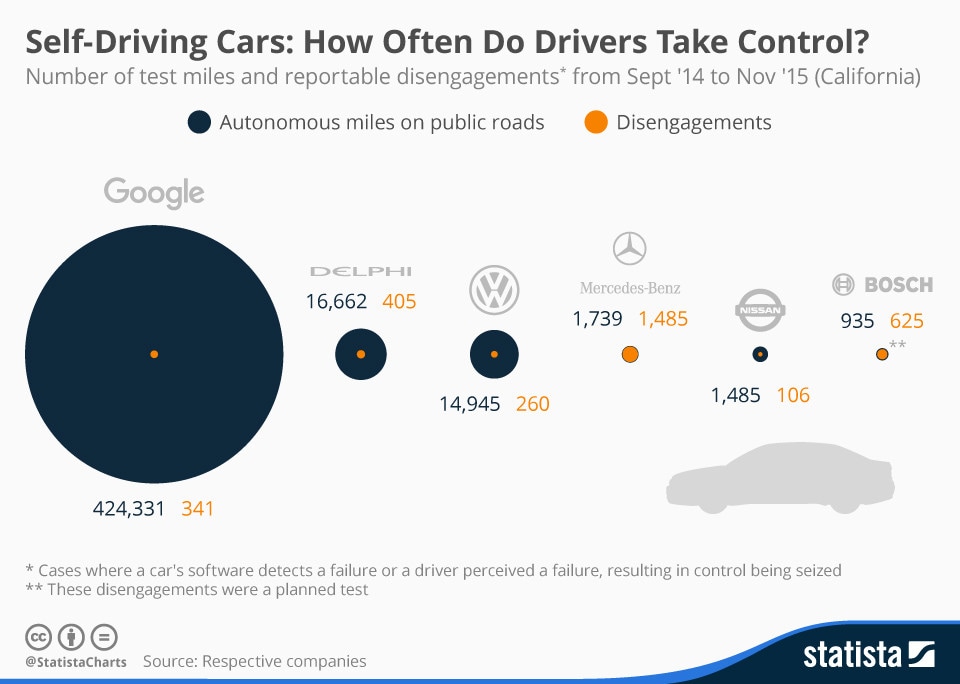How safe are robot drivers?

A sensor is seen spinning atop a Google self-driving vehicle. Image: REUTERS/Stephen Lam

Get involved with our crowdsourced digital platform to deliver impact at scale
Stay up to date:
Automotive and New Mobility
Self-driving cars will soon be considered legal “drivers” in the US, however news of a recent crash between one of Google’s autonomous vehicles and a bus may call into question their impressive safety record.
Google compiled an accident report detailing the crash between its self-driving vehicle (SDV) and a bus. The report found that the autonomous car was driving at 2mph when it pulled out in front of the bus travelling at around 15mph.
The test driver in the car said he saw the bus approaching but “believed the bus would stop or slow down to allow the Google AV (autonomous vehicle) to continue”, according to the accident report.
The crash came just days after the National Highway Traffic Safety Administration (NHTSA) released a letter supporting Google’s claim that self-driving cars should be allowed on the same roads, covered by the same laws as vehicles driven by humans.
This victory for Alphabet, Google’s parent company, is a big step forward for the company’s driverless car project. However if the Google car is considered to be at fault for the collision, it could be a setback in the company’s plans.
This letter from the NHTSA isn’t an official ruling, it is rather a clarification of how it will interpret the law in the future. The agency refers to the development of motor vehicle design, with the introduction of antilock brakes, automatic emergency braking and the current development of self-driving vehicles (SDV).
They then conclude that: “If no human occupant of the vehicle can actually drive the vehicle, it is more reasonable to identify the driver as whatever… is doing the driving.”
In response to the crash Google have refined its self-driving algorithm: “From now on, our cars will more deeply understand that buses (and other large vehicles) are less likely to yield to us than other types of vehicles.”
How safe are driverless cars?
Forecasters suggest the era of self-driving cars will soon be upon us, with robot drivers expected to be taking to the roads by 2020. The main concern for most road users is likely to be the safety of cars controlled by robotic drivers.
When looking at how often humans have to take control of self-driving vehicles, researchers found that the main developer, Google, saw the smallest percentage of “disengagements”. Drivers in Google’s SDV took control for less than 1% of the overall miles driven.

The percentages for other companies are higher, but this may be due to their systems being less developed. Google has also tested its vehicles over many more miles than its competitors.
The percentage of miles where drivers took control is still relatively small: Delphi’s SDV disengaged around 2.5% of miles, while Volkswagen had only 260 miles out of almost 15,000 miles.
On the other hand, Mercedes-Benz had a considerably higher rate of disengagement – over 85% of miles were driven with humans in control.
Autonomous cars are predicted to account for 75% of vehicles by 2040, so are robot drivers really safer than human drivers? According to Insurance Quotes more than 90% of all car accidents are caused by human error. The leader of Google’s SDV project Chris Urmson has claimed that self-driving cars are a safer option: “Our car is driving more smoothly and more safely than our trained professional drivers.”
Google’s June 2015 accident report showed 14 minor incidents involving the SGVs over the past six years, however Urmson has confirmed that the minor accidents were the fault of other drivers and couldn’t be blamed on the technology.
Director of customer relations at Consumer Watchdog, John M. Simpson, believes the technology is still very much in development.
In an interview with Tech Times he said: “In the long run, I think that some of the autonomous technology will probably enhance safety, but I think it’s going to be quite a while until we get to that point – if we even can.”

Despite discussion about the current safety of driverless cars, it seems people are open to trying out the technology. An analysis by the Boston Consulting Group of data from the World Economic Forum shows that more than half of us would take a ride in a self-driving car.
The World Economic Forum has partnered with the Boston Consulting Group on a project to look into self-driving vehicles in an urban context.
Have you read?
Don't miss any update on this topic
Create a free account and access your personalized content collection with our latest publications and analyses.
License and Republishing
World Economic Forum articles may be republished in accordance with the Creative Commons Attribution-NonCommercial-NoDerivatives 4.0 International Public License, and in accordance with our Terms of Use.
The views expressed in this article are those of the author alone and not the World Economic Forum.
Related topics:
The Agenda Weekly
A weekly update of the most important issues driving the global agenda
You can unsubscribe at any time using the link in our emails. For more details, review our privacy policy.
More on Supply Chains and TransportationSee all
Nick Pickens and Julian Kettle
April 22, 2024
Rida Tahir
April 9, 2024
Kimberley Botwright and Spencer Feingold
March 27, 2024
Andrea Willige
March 19, 2024






